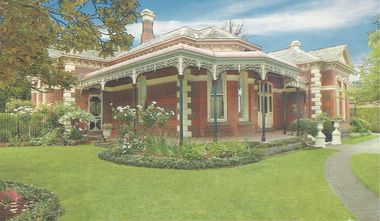Front Verandah
 The design of the verandah seems to have been more tedious than the design of the frame for the whole house. I am not sure why.
The design of the verandah seems to have been more tedious than the design of the frame for the whole house. I am not sure why.We have chosen a roof profile that is radiussed in such a way that it is convex on the top. Some Victorian homes also had it around the other way, so its concave on the top surface. We like both versions, but eventually we went with convex.
We painted all the verandah components (posts, rafters, battens) before our carpenter installed the frame over. The posts are laminated clear-pine, rafters are clear-pine radiussed to about 4metres. The base of each post is made from merbu so it wont rot, and its mounted on a hot-dipped galvanised steel stirrup (currently this puts the post 50mm above the concrete to allow 40mm for the tiling of the verandah).
Posts are modelled on a commonly used design from the Victorian period (octagonal base, fluted body, Corinthian capital, with cast-aluminium lace [not fitted yet] between the capital and the verandah beam).












